![]()
Introduction
Béatrice et Bénédict
Benvenuto Cellini
Les Troyens
La Damnation de Faust
Conclusion
Chronology
Illustrations
This page is also available in French
Copyright notice: The texts, photos, images and musical scores on all pages of this site are covered by UK Law and International Law. All rights of publication or reproduction of this material in any form, including Web page use, are reserved. Their use without our explicit permission is illegal.
![]()
Our opera houses need to be aware of the role they have to
play in the posthumous rehabilitation of the illustrious composer (Ernest Reyer
in 1869)
It is extremely regrettable that our opera houses never stage any opera by this
remarkably individual composer (Oscar
Comettant in
1886)
A series of pages on this site have traced the fortunes of Berlioz’s music in Paris from the time of his death in 1869 to the outbreak of the First World War in 1914: pages on the Berlioz revival of the 1870s and early 1880s, on the conductors Jules Pasdeloup, Édouard Colonne and Charles Lamoureux and the concert societies they founded, and on the Société des Concerts du Conservatoire. Two points emerge from the material thus collected. The first is that the success of Berlioz’s music was achieved primarily in the concert hall, not on stage, and was due primarily to the initiative of the conductors of those concert societies. The second is that there was a striking contrast in this respect between France and Germany, where Berlioz’s music was performed successfully not only in the concert hall, but also in the opera house: it was a German conductor, Felix Mottl, who had the distinction of being the first to conduct staged performances of all three of Berlioz’s operas. This page reviews in more detail the evidence for the performance of Berlioz’s operas on stage in France in this period and attempts to draw some general conclusions. The fate of Berlioz’s dramatic works will first be examined individually.
Béatrice et Bénédict was never performed in France during Berlioz’s lifetime: it was in Baden-Baden that it received its first performances (9 and 11 August 1862), and the opera was staged again there the following year (14 and 18 August 1863). It was also performed several times in Weimar in 1863 (8 and 10 April, 29 May, 13 November), and in Stuttgart in November 1864 (CG no. 2922). But in Paris all that was heard of the work in the composer’s lifetime was the duet of the women at the end of Act I; apart from a few private hearings (CG nos. 2605-6 and 2385) it was successfully performed several times at the Conservatoire (22 March, 5 and 8 April 1863; 22 March 1865; see CG nos. 2701, 2706 on the first performance at the Conservatoire). Nothing changed in the years immediately following the composer’s death: in Paris only the duet received a few performances in the 1870s and 1880s at the Colonne and Lamoureux concerts, and the rest of the work, including the overture, was virtually unknown to the public. In Germany, by contrast, the opera was performed again in Weimar in 1876, then staged in Karlsruhe in 1887; for the occasion recitatives were composed by Felix Mottl to take the place of the original spoken dialogue, as Hans von Bülow had planned to do in 1879 in Hanover. Thereafter the opera was performed with some frequency in other German cities apart from Karlsruhe, among them Vienna, Munich, Riga, Leipzig, Frankfurt, and Hamburg (see also Le Ménestrel 28/10/1900; 20/9/1913).
The neglect in France of Berlioz’s last opera was one of the considerations which lay behind the belated foundation in Paris in April 1890 of a new association, the Société des grandes auditions musicales de la France; it was led by a group of patrons of the arts drawn from the aristocracy and from the cultural establishment of France, and assisted by a consultative committee which included a number of the leading French composers and musicians of the day. The declared aims of the association were publicised in the Paris press: they were to secure the performance in Paris of French operatic works which had been neglected in France and consequently had been obliged to find a home in opera houses abroad. The manifesto of the association gave as examples a number of contemporary French composers, and specifically mentioned the case of Berlioz; the first production sponsored by the association was to be that of Béatrice et Bénédict at the Odéon theatre, performed by Lamoureux and his orchestra. The first performance took place on 3 June 1890. Two reviews of this production are reproduced on this site, by Amédée Boutarel in Le Ménestrel and Ernest Reyer in the Journal des Débats. Both writers knew and admired the music of Berlioz, and Reyer had been a friend of the composer in his later years. They welcomed the performance and praised much of the music, though both found the work itself rather old-fashioned. Boutarel regretted that the Société des grandes auditions should have started with Béatrice et Bénédict rather than any of the other operas; in his view this gave an inadequate idea of Berlioz as a composer of operas, whom he rated after Wagner as ‘the boldest, most independent, vigorous and innovative, and most essentially poetic of all the dramatic composers of his age’. Boutarel was critical of the spoken dialogue of Béatrice et Bénédict, which he thought ‘lacking in finesse and wit’: Berlioz ‘had not reproduced Shakespeare well’. Neither of the two critics was aware of the fact that the dialogue used in 1890 was not in fact Berlioz’s original text, which was not available at the time, but had been specially composed for the occasion (by Charles Bannelier, the editor of the Revue et Gazette musicale). This important detail was pointed out years later by Julien Tiersot (Berlioziana, 27/10/1906, p. 336), who remarked that the original version of the work had yet to be staged in France… In the event, the 1890 production only ran for a total of 5 or 6 performances, and did not have any lasting impact: the work subsequently dropped out of the operatic repertoire. The production was retrospectively judged a failure which had not helped the cause of Berlioz (H. Moreno, Le Ménestrel 4/1/1891). Two years later a critic could state that in France Berlioz’s operatic output was simply unknown (S. Gigon, Le Ménestrel 19/11/1893). As for the music of the opera, nothing changed: a single performance of the overture in 1909 at the Concerts Lamoureux was hardly noticed. Only the duet continued to be performed regularly (some 30 performances in all by the various concert societies between 1876 and 1907). Concerning a performance in 1897 one critic commented: ‘the duet … is very pretty and poetic, but is the only piece to have survived from a little opera written for the theatre in Baden-Baden which is extremely mediocre’ (H. Barbedette, Le Ménestrel 24/1/1897). As late as 1913 a sympathetic writer noted that the opera ‘is treated with rather too much disdain in France, particularly since M. Lamoureux conducted a few performances at the Odéon but only succeeded in bringing out its weaknesses and depriving the work as a whole of its poetry. It is frequently played in Germany but in France it has only been performed on the occasion referred to, and it belongs to a group of works that have been killed off beyond recall by the fanatical and heavy-handed cult of Wagner’ (Le Ménestrel, 20/9/1913).
Benvenuto Cellini, the first opera of Berlioz to be performed in Paris in his lifetime was also the last to be staged again in Paris after the composer’s death. The failure of Benvenuto Cellini at its first production in 1838 had a deep effect on Berlioz’s career as a composer: henceforward the Opéra was closed to him and this restricted the kind of music he could write and expect to be performed. Berlioz seems to have given up any hope that the opera might be staged again anywhere and did not publish a full score of the complete work. But for the initiative of Liszt who, with the assistance of the composer, staged Benvenuto Cellini in a modified and condensed form in Weimar in 1852 and again in 1856, Berlioz might never have touched the work again and it would have remained as he had left it. The failure of 1838 was also taken to heart by Berlioz’s supporters such as Théophile Gautier who responded to the event with a review which emphasised the novelty of the music; more than thirty years later, in his obituary of the composer, Gautier called for a new production of ‘this daring and original work, full of invention, which would be readily welcomed nowadays and might stand a chance of achieving posthumous success’. In the same context another writer (Timothée Trimm) expressed his confidence that some opera director would stage Benvenuto Cellini again.
But this was very slow in coming, and the first move came not from France but from Germany. In 1879 Hans von Bülow, who had played a major part in the Weimar revival of 1852, staged the work successfully in Hanover, and the event was duly noted in the Paris press (see Le Ménestrel 22/9/1878 and 19/1/1879). The example was taken up elsewhere, in London in 1882 (by the Carl Rosa opera company), and in Leipzig in 1883 under the young Arthur Nikisch. The pianist Marie Jaëll, a friend and admirer of Berlioz, attended one of the performances in Leipzig and wrote enthusiastically about the work; it was also rumoured that the publisher Choudens was now thinking of staging the work in Paris. Nothing happened on that front; the following year a similar intention was credited to another impresario, but again without result. In 1886 prospects appeared more hopeful. Plans were afoot to launch the Eden theatre as an opera house the following year (1887), with Charles Lamoureux conducting Wagner’s Lohengrin, to be followed by other works including Benvenuto Cellini, though it was not clear how serious was Lamoureux’s commitment to the Berlioz opera. Much more promising was the initiative of Carvalho, the director of the Opéra-Comique, who more than two decades ago, in 1863, had staged Les Troyens à Carthage at the Théâtre-Lyrique for the first time. Perhaps at the prompting of Ernest Reyer, and with active encouragement from Marie Jaëll, Carvalho now made the decision to stage Benvenuto Cellini and preparations were begun in earnest; but delays started to build up, and the first performance, which had been intended to coincide with the inauguration of Berlioz’s statue at Square Vintimille on 17 October 1886 had to be postponed. By the early months of 1887 the whole project was abandoned altogether, much to the disgust of Ernest Reyer. In the meantime the long-term effects of Bülow’s initiative were being felt elsewhere: one German opera-house after another took up the work which started on a long run of success in that country. In 1889 the Rouen opera reportedly included Benvenuto Cellini among its planned future productions, but again nothing followed. By 1893 one French critic (S. Gigon) could state that Benvenuto Cellini had been forgotten since 1838. A very successful appearance by the German conductor Felix Mottl at the Concerts Colonne on 18 March 1894 aroused fresh hopes: for several years Mottl had been closely associated with the promotion of Berlioz’s operas in Karlsruhe, and plans were now drawn up for two performances in Paris of Benvenuto Cellini in April and May 1895, as well as both parts of Les Troyens; all of them were to be conducted by Mottl. But once again the project failed to materialise, and it would be many years before the idea was revived.
In the meantime all that was heard of the opera in the concert hall in Paris were the two overtures, Benvenuto Cellini and le Carnaval romain, both of them very popular pieces with audiences and with all the leading concert societies (much as was the case with the duet from Béatrice et Bénédict). Thoughtful critics occasionally reflected on this and lamented the absence of the work from the stage (H. Barbedette, Le Ménestrel 11/3/1894 and 17/12/1899; O. Berggruen, Le Ménestrel 1/2/1903). But, again as with Béatrice et Bénédict, none of the concert societies ever contemplated the idea of giving a complete concert performance of the opera. When it came to the centenary celebrations in 1903 Benvenuto Cellini was conspicuously absent from any French stage, while at the same time in Germany the work continued to be popular (for the celebrations in Germany Le Ménestrel mentions performances in Dresden, Munich, Metz, Brunswick, Freiburg and Strasbourg). In his pioneering study of Benvenuto Cellini published in 1905, the first attempt to unearth the opera in its original form, Julien Tiersot ended with the comment that it was Berlioz’s least-known work [sc. in France] and went on to list no less than 18 cities in Germany where it had been performed to date.
A new initiative eventually emerged in Paris, and this time it was eventually successful. The first step was the creation in 1908 of the Fondation Berlioz, founded by Henri Martin, the father of Jacques Barzun, an organisation devoted to promoting the composer, and in the following years it showed some activity. The second was the foundation of a new opera house, the Théâtre des Champs-Élysées, directed by Gabriel Astruc, an impresario who had been very active in Paris for several years. For instance, he organised in May 1905 a series of Beethoven concerts conducted by Felix Weingartner (Le Ménestrel 7/5/1905, p. 149 and 14/5/1905, p. 157), and in April-May of the following year another series, devoted to Beethoven and Berlioz, also conducted by Weingartner (Le Ménestrel 8/4/1906, p. 108; 22/4, p. 122; 29/4 pp. 129-30; 6/5, p. 13). The Foundation Berlioz joined forces with Astruc and the new opera-house was inaugurated on 3 April 1913 with the first performance of Benvenuto Cellini in Paris since 1938, conducted by Felix Weingartner. The work apparently ran for half a dozen performances in April and May (only the general rehearsal and the first performance were conducted by Weingartner). Two reviews of the opening performance are reproduced on this site. One is by Adolphe Jullien, a long-standing champion of Berlioz in France, and is much the most positive: France has at long last followed the example of Germany, and Jullien hopes that the work’s many qualities will ensure its lasting success. The other is by Arthur Pougin. The tone is noticeably cool, and though the writer welcomes the production and praises the performance, he suggests the revival was of only historical interest: in his view the work was not destined to survive in the repertoire… In the event this negative prophecy could not be put to the test: the new theatre had to close down in the autumn through lack of funds (Le Ménestrel 8/11/1913, pp. 359-60), and by summer of the following year Europe was engulfed in the First World War. But a century later Benvenuto Cellini had clearly not established itself as a regular part of the operatic repertoire in France.
Of all Berlioz’s operas Les Troyens was the one most likely to be familiar to the Paris public after the composer’s death — or at least over half of the work was, thanks to the 21 performances of acts 3-5 (but with cuts) of the original 5-act opera given at Carvalho’s Théâtre Lyrique in November and December 1863 (for comparison, in 1838-9 Benvenuto Cellini received only 4 complete performances, after which Act I was performed 3 more times in 1839, but paired with an act from another opera). Berlioz had been forced to divide the work into two parts, La Prise de Troie and Les Troyens à Carthage, if he was to hear any of it performed in his lifetime (he never heard the first two acts). Significant numbers of the concert-going public will have attended and remembered some of these performances, and the Septet from Act IV was performed several times by Pasdeloup, notably at a concert on 7 March 1866. Berlioz was present on this occasion and received an ovation from the large audience; the event was reported in the press.
It is perhaps no accident therefore that music from Les Troyens was to start to figure in concerts earlier and with greater frequency than with the two other operas. The Septet was performed at the commemorative concert on 22 March 1870 organised by Ernest Reyer a year after the composer’s death; Oscar Comettant commented on this occasion ‘Les Troyens are still very much alive in the memory of music-lovers in Paris who heard this opera at the Théâtre Lyrique, so there is no need to analyse here the wonderful Septet it contains which has been greeted enthusiastically every time it has been performed’. At one of his concerts in 1874 Colonne gave what was apparently the first performance of the Marche troyenne as a separate concert piece (1 March), and when he repeated the piece at another concert a few years later (9 May 1877). Ernest Reyer was moved to reminisce on his experiences in 1863: ‘the concert ended with the noble and stirring march from les Troyens à Carthage, which reminded us of those beautiful evenings at the Théâtre Lyrique’. At the end of his review he described Berlioz as ‘the illustrious author of les Troyens’ from whom ‘many had learned so much’. The following year (17 February 1878) Colonne introduced the Chasse royale et orage in one of his concerts, and at another concert on 6 June he included the Septet. To celebrate the tenth anniversary of the composer’s death Ernest Reyer organised a concert at the Hippodrome (8 March 1879); as well as the familiar Septet it included the first performance of the imposing chorus ‘Dieux protecteurs’ from Act I of la Prise de Troie. The concert was a success, and this may have suggested to Pasdeloup, who by now was competing for supremacy with Colonne, the imaginative idea of giving a concert performance of the complete Prise de Troie. Colonne lost no time in imitating his example, and the complete work was thus heard in Paris for the first time in the concert hall in a series of performances at the two rival societies in November and December 1879. This was a significant event in Paris musical life, and the work elicited an unusual number of reviews in Le Ménestrel; individual critics differed in their opinions, but there was general praise for the work, and the enthusiasm of the public grew with each successive performance. Ernest Reyer was moved to express the hope that Béatrice et Bénédict and Benvenuto Cellini might also receive similar concert performances (Journal des Débats 12/12/1879).
In the event, as seen above, this did not happen, and it took many years before Les Troyens à Carthage was performed (almost) complete at the Concerts Colonne (22 & 29 October 1905). But excerpts from les Troyens continued to be performed by one or other of the two major concert societies of Colonne and Lamoureux almost every year between 1881 and 1913 (again, the contrast with Béatrice et Bénédict and Benvenuto Cellini is obvious). Among orchestral excerpts the Marche troyenne, the Chasse royale et orage and ballets from Act IV were performed with some frequency. The opening aria of Cassandra (Act I) and closing aria of Dido (Act V) were popular vocal excerpts with the leading singers of the time. Colonne even occasionally performed Act IV complete, first at a Berlioz Festival in December 1881, then again 3 times in 1888 (19 & 26 February, 6 April). The Conservatoire, by contrast, was characteristically unadventurous: it performed the Marche troyenne only once (in 1889) and gave two performances of scenes 2 and 3 of Act I of la Prise de Troie (26 March and 9 April 1899); although the excerpts were very well received the experiment was not repeated.
On the occasion of the concert at the Hippodrome in March 1879 Ernest Reyer had commented (Journal des Débats, 22/3/1879) that ‘there is no more prospect in Paris of performing la Prise de Troie on stage than les Troyens à Carthage or Benvenuto Cellini. The momentum developed for Berlioz’s music by the directors of our concert societies has not been followed up by the directors of our opera houses, who clearly have more important things to do’. His pessimism was justified by events: it was years before either part of Les Troyens reached the stage in France. Apparently the first initiative came not in Paris but in Nice in February 1891. At the time the Nice opera was under the directorship of the enterprising Raoul Gunsbourg (on whom see further below), who put on a truncated version of the opera, consisting of La Prise de Troie and excerpts from Les Troyens à Carthage; it was greeted with sarcasm in Le Ménestrel (see the issues of 25/1/1891, where the production is described as ‘a casino fantasy’, and 5/4/1891), and several years later Adolphe Jullien expressed a similarly negative view: the production was ‘a miserable travesty’ and Gunsbourg is dismissed as a Vandal (un barbare impresario). This should be compared with the (manifestly uncritical) praise from a reviewer in L’Univers illustré (14/2/1891 with the attached note). At any rate the production was apparently not revived in Nice after this.
At this point the Société des grandes auditions musicales de la France went into action and joined forces with Carvalho: the result was the first staging of Les Troyens à Carthage in Paris in nearly 30 years (9 June 1892), at the same theatre and under the same director as in 1863 (see the illustrations below). The great attraction of the production was the first appearance of a 17-year old singer of exceptional talent, Marie Delna, who made a great impression and went on to a glittering career on stage and in the concert hall (she performed arias from Les Troyens in concert on a number of occasions: at the Concerts Lamoureux on 21/1/1900, at the Concerts Colonne on 17/3/1907 and 13/12/1908). But as a whole the performance had the same faults as those of 30 years earlier: the theatre was too small for the work, and once more cuts were made, as Julien Tiersot emphasised in a long and detailed review (Le Ménestrel 12/6/1892); see also the reviews by A. Boisard and Fernand Bourgeat — the latter a rather uncritical piece. The production did not stay long in the repertoire of the theatre, as reported by a critic the following year (S. Gigon, Le Ménestrel 19/11/1893): it had been ‘disfigured by shameful mutilations and performed in an off-hand manner that would be considered unacceptable for a work by Adolphe Adam’. The following year hopes arose that both parts of Les Troyens might be staged in Paris in April and May 1895, with Felix Mottl as conductor (Le Ménestrel 29/4, 26/8 and 9/9/1894), but as seen above in the case of Benvenuto Cellini the plans eventually came to nothing. The following year (1896), there was a project to put Colonne in charge of an opera house in Paris in 1896, with the possibility of performing the complete Les Troyens in two consecutive evenings, but the plan fell through.
As for la Prise de Troie, it had to wait till 1899, 20 years after the concert performances of Pasdeloup and Colonne, and 30 years after the composer’s death, before it reached at long last the stage of the Paris Opéra (the Société des grandes auditions was not involved in this project). On this occasion too, as in 1892, the leading role was sung by Marie Delna. Several reviews of this production, together with a number of photographs, are reproduced on this site: apart from a short piece signed A. de L., the most substantial contributions come from Arthur Pougin and from articles in two different journals by Adolphe Jullien in 1899 and 1900. In the event the production ran to several performances in 1899 and 1900, but did not stay in the repertoire, and the hopes expressed by Jullien that the Opéra would stage the rest of the work were not fulfilled. Les Troyens à Carthage did reappear on stage in France, but not at the Opéra and only in an open air performance at the Théâtre d’Orange on 5 August 1905, conducted by Colonne, under the auspices of the Société des grandes auditions (this was its last initiative on behalf of Berlioz’s dramatic works). To judge from a review signed V.T., which was itself less than satisfactory, the performance was not very successful; it was disfigured by the cuts that had plagued the work in Paris since 1863, and it suffered from the open-air conditions (see also the comments by Raymond Bouyer not long after). That was the end of Berlioz’s great epic masterpiece on stage in France until after the First World War. Les Troyens did not manage to secure a lasting place in the repertoire in France, and no opera house was prepared to undertake what Felix Mottl had done several times in Germany, and which the Théâtre de la Monnaie in Brussels did in 1907, that is to treat the work as a single whole which ideally should be played consecutively on the same day. Until this was done the work as originally conceived by the composer could not be assessed at its true worth.
In principle La Damnation de Faust should not figure in the same company as the three operas of Berlioz discussed above, since it was written, published and performed by Berlioz as a purely concert work. But paradoxically, as well as becoming by far the most successful concert work of Berlioz in France after his death, it was the only score of Berlioz to achieve the sustained success on stage that was denied to his genuine operas in this period in France.
The remarkable success of La Damnation as a concert work dates back to February 1877 and is particularly associated with the name of Édouard Colonne; the success of the work as an ‘opera’ started later, in 1893, but the idea of transferring the work to the stage emerged well before this. Indeed, Berlioz himself may be said to have indirectly encouraged this. While composing the work during his second trip to Germany he initially described it under the somewhat ambiguous title of ‘concert opera’. In a letter to Joseph d’Ortigue of 13 March 1846 (CG no. 1028) he refers to his ‘large opera of Faust (a concert opera in 4 Acts) on which I am working furiously and which will soon be completed’. Not long after (24 and 25 March) he writes to his sister Nanci (CG no. 1029): ‘I have been working a great deal on a concert opera in four acts called La Damnation de Faust, of which I have had to write nearly half of the words, as the libretto was not completed when I left Paris’. In a feuilleton in the Journal des Débats of 6 September 1846 (reproduced in CM VI p. 221) Berlioz alludes to the composition in progress of the Damnation which he describes as ‘a sort of opera’. In the autograph score the title page originally described the work as a ‘Concert opera in four parts’, but the words ‘Concert opera’ were then crossed out and replaced by the word ‘Legend’ (see the reproduction in NBE vol. 8b p. 493). In the published score the Acts were now called Parts, numbered I-IV, but every scene is given a title and is accompanied by quasi-stage directions. Thus for Part I: ‘Scene I. The Hungarian plains. Faust alone in the fields at sunrise. Scene II. Dance of peasants. Scene III. Another part of the plain. An advancing army. Hungarian march. The army passes by. Faust walks away’. But for the failure of Benvenuto Cellini at the Opéra in 1838 it is quite possible that Berlioz would have designed the work as an opera. When he went to London in 1847 to become conductor of the Drury Lane theatre and was required by his contract with Jullien to provide an opera for the coming season Berlioz initially thought of developing la Damnation for the stage with the collaboration of the librettiste Eugène Scribe. As is known from several letters he wrote to Scribe, the revised and enlarged work would have been called not Faust but Mephistopheles, who would have been assigned a larger role than in the original work. In the end the project came to nothing and it is not mentioned in the Memoirs. La Damnation was eventually published in 1854 as a purely concert work, and it was in this form that Berlioz always performed it, at the Opéra-Comique in Paris (6/12 and 20/12/1846), in Berlin (19/6/1847), Dresden (22/4 and 25/4/1854), Weimar (1/3/1856) and Vienna (16/12/1866).
It is striking that almost from the moment when la Damnation established itself in Paris as Berlioz’s most successful concert work the idea of transferring it to the stage began to emerge. Auguste Morel, a close friend of Berlioz, reviewing a performance of the first two parts by Pasdeloup on 11 February 1877 referred to the work as ‘this concert opera which could without too much difficulty become an opera for the theatre’. A week later, after the first performance of the complete work to be given by Colonne (18 February 1877) Morel commented that the success of the work ‘would guarantee more than 100 performances if instead of being a concert opera la Damnation was an opera for the theatre’. Evidently he did not have any objections of principle to the idea. A few years later the critic Hippolyte Barbedette pressed the idea more strongly: ‘When listening to this remarkably original score, one of Berlioz’s finest, we wondered whether it would not be powerfully assisted by the prestige of a staged production. In Germany some oratorios are occasionally performed with an appropriate staging which greatly enhances their impact. There would be great difficulties to overcome with la Damnation de Faust, but the experiment is worth attempting’ (Le Ménestrel 24/12/1882). A year later he repeated the point: ‘May we repeat here what we have said many times: we are convinced that some works, such as Berlioz’s Faust and Félicien David’s Le Désert, would gain enormously if they were staged in some way, with appropriate sets which would maintain the illusion and double the effect’ (Le Ménestrel 30/12/1883). Some years later he extended the suggestion to l’Enfance du Christ (Le Ménestrel 11/12/1892), which was indeed eventually staged in Brussels in 1911 (Le Ménestrel 1/4/1911), though apparently not as yet in France.
Others, however, had objections of principle to the idea of transferring Berlioz’s concert work to the stage. See for example the critical views expressed briefly by a number of writers in Le Ménestrel (27/1, 3/3 and 16/6/1895; 21/9/1902; 1/2/1903; 1/4/1911). Another critical voice was that of Charles Malherbe: it is to his credit that he unhesistatingly rejected the idea (see the programme note of 11/12/1898). A more developed critique was that by Albert Bertelin in his review of the 1910 performances at the Paris Opéra. The most determined opponents were two of the leading Berlioz champions of the time: Ernest Reyer, who has been repeatedly mentioned in this page (see here his 1895 article), and Adolphe Jullien, who resisted the idea with particular tenacity over a long period of time, and in 1902 publicly criticised Berlioz’s heirs (the Chapot family) for allowing Berlioz’s work to be adapted for the stage (see his articles in the Journal des Débats in 1893, 1902, 1903, 1910). Later on, in the early 1920s, he could not but deplore the fact that la Damnation was now becoming more popular in Paris in its staged version than as the original concert work (1921, 1923, 1924).
Plans to stage la Damnation de Faust in Paris are mentioned in 1884 (Le Ménestrel 6/1/1884), though they came to nothing. In the event it was not in Paris but in Monte-Carlo that the first successful move was made, and it is associated with the name of the impresario Raoul Gunsbourg (1860-1955). Romanian-born, and a man of considerable talent — he did not study at the Conservatoire and was largely self-taught — Gunsbourg’s career developed outside the Paris musical establishment. It was assisted by the support of influential patrons: first the Tsar of Russia Alexander III, later that of Prince Albert of Monaco, who was himself a Berlioz enthusiast. Gunsbourg was briefly director of the opera houses of Lille (1888-1889) and then of Nice (1889-1891), where he staged a truncated version of Les Troyens, which he managed to misname La Prise de Troyes (Le Ménestrel 25/1/1891; 5/4/1891). But it was his appointment in 1892 as director of the Monte-Carlo theatre that marked the turning point in his career. He went on to hold the post for almost 60 years till 1951, the longest tenure in operatic history. His reputation among some Paris critics was initially very mixed, for example with Adolphe Jullien (see his articles mentioned above and those of 1899 and 1900) or the veteran theatre critic H. Moreno, contributor to Le Ménestrel from April 1868 till the eve of the First World War (cf. Le Ménestrel 5/4/1891): Gunsbourg may have been regarded as too much of an independent-minded outsider. But through his enterprise and imagination, and with the support of the Prince of Monaco (cf. Le Ménestrel 9/3/1902), he raised the standing of the Monte Carlo opera to the point where it ranked as among the best of the day.
Among the productions that brought him to international notice was his staging of La Damnation de Faust in Monte Carlo: the first performance on 18 February 1893 was a sensation (Le Ménestrel 26/2/1893). Just as the concert version of the work had spread from France to other countries in Europe and across the Atlantic, so too staged versions became rapidly popular abroad, starting with Italy and London in 1894 (see for example reports on performances in Milan, Moscow, and several German cities in 1903, in Brussels in 1906, and in Berlin in 1907). Paris was slower to follow: there was talk of a staged Damnation in 1895 (Le Ménestrel 27/1 and 3/3/1895; Ernest Reyer, Journal des Débats 25/5/1895), but after a few months the idea was abandoned (Le Ménestrel 16/6/1895). It was not till the centenary year 1903 that the plan eventually took shape in Paris, by which time staged performances had become almost commonplace abroad. Early in that year it was rumoured that the Gunsbourg production would be staged at the Théâtre Sarah-Bernhardt (Le Ménestrel 25/1, 1/2 and 8/2/1903), and the first performance eventually took place on 7 May; it was conducted, appropriately, by Édouard Colonne. Detailed reviews, by Arthur Pougin and (much more critical) by Adolphe Jullien, are reproduced on this site. The production was very successful; it received the public endorsement of Berlioz’s heirs, though this must have come as a disappointment to Ernest Reyer who some years before had strongly opposed the idea, as had Adolphe Jullien from at least 1893 onwards. Several years later the production was revived, again very successfully, but this time at the Opéra; the first performance was on 10 June 1910 (see the illustrations below). Three reviews are reproduced on this site, one by Arthur Pougin (again), the second by Albert Bertelin (with illustrations), who but unlike Pougin was critical of the very idea of transferring the work to the stage, and the third by Jullien himself, who as mentioned had consistently objected to the performance of Berlioz’s work other than as written by the composer. Be that as it may, Gunsbourg’s production of La Damnation de Faust must rank as one of the most successful ventures in operatic history: it received no less than 350 performances in Monte Carlo between 1893 and 1949. But one cannot help observing that Gunsbourg did not exploit the success of this production to promote any of Berlioz’s real operas, none of which he staged (with the exception of the truncated Les Troyens in Nice in 1891): respect for the composer’s wishes was not his highest priority.
More than four decades after Berlioz’s death the response of French opera houses to the call made by Ernest Reyer in 1869 remained limited. As regards Berlioz’s operas in France Oscar Comettant, had he been alive in 1914, might have concluded that the situation had only marginally improved since his pessimistic assessment of 1886. Apart from the successful staging of La Damnation de Faust, performances of the operas were few and far between, and none of them had been staged as originally written by the composer. Béatrice et Bénédict was given without its original dialogue (1890), La Prise de Troie and Les Troyens à Carthage continued to be treated as two separate operas and the latter was never given without cuts (1892, 1899, 1905), and Benvenuto Cellini was only staged very late and in the shorter Weimar version (1913), not the original and more developed Paris version which was known only to a few musicologists like Julien Tiersot. The centenary celebrations of 1903 showed once more the disparity between Germany and France: not a single opera of Berlioz was staged in France in that year, whereas in Germany they continued to be performed as before (though it should be noted that operas by other French composers were far more popular there than those of Berlioz, as shown for example by the figures for the year 1900).
Two related reasons might be advanced to explain the difference. The first was institutional: as Berlioz had experienced in his first German tour of 1842-3, the political fragmentation of the German-speaking world at the time had as welcome consequence its cultural decentralisation. Almost every city of any significance had its theatre and opera house, and though many of these were modest in scale compared with those of capital cities such as Berlin, Vienna, Paris or London, they were active and enterprising. Benvenuto Cellini was revived in 1852 by Liszt in Weimar and by Hans von Bülow in Hanover in 1879; Béatrice et Bénédict was first performed in 1862 in Baden-Baden, and over the next two years in Weimar and Stuttgart as well; the first performance of the complete Les Troyens was given over two evenings by Felix Mottl in Karlsruhe in 1890. None of these was a large capital city. In France, by contrast, cultural life was far more concentrated in Paris, and it needed the enterprise of a Raoul Gunsbourg in Monte-Carlo (and briefly in Nice before) to innovate outside the confines of the capital. In Germany, furthermore, the separation between music-making in the concert hall and at the opera was less clear-cut than in France. The leading German conductors of the day (Hans von Bülow, Hans Richter, Felix Mottl, Felix Weingartner, among others) moved more freely between the concert hall and the opera house and occupied themselves equally with the symphonic and the operatic repertoire. In France, by contrast, Pasdeloup, Colonne and Lamoureux did all at one time or another conduct in the theatre, but the major part of their activity was associated with the concert societies they had founded in Paris.
The second reason was cultural: the German musical public, and the conductors who catered for it, could be said to have had a broader and deeper view of Berlioz as a composer. To varying degrees the leading advocates of Berlioz in Germany drew both on his symphonic and on his operatic repertoire (this is true at least of Hans von Bülow, Felix Mottl, Felix Weingartner, and Richard Strauss, whereas Gustav Mahler seems to have done little to promote Berlioz’s operas). By comparison the received view in France of Berlioz as a composer was more restrictive (on this point see further P.-R. Serna in L’Herne. Hector Berlioz [2003], pp. 187-212). For most French music-lovers Berlioz was thought of above all as a symphonic writer: he was persistently described as ‘our great French symphonic writer’ (notre grand symphoniste français), a phrase that constantly recurs in the critical writing of this period and goes back to the composer’s lifetime. In an article of 1845 Berlioz is referred to as ‘the fiery composer of symphonies’ (le fougueux symphoniste), even though by this time he had also composed the Requiem and Benvenuto Cellini (Le Ménestrel 26/1/1845). In France the label stuck to his name for decades after his death, and was used by writer after writer, including those who had known him well: among others Auguste Barbier in 1872 in an article on Benvenuto Cellini, Auguste Morel repeatedly in reviews of the late 1870s (Le Ménestrel 4/3, 13/5 and 4/11/1877; 16/3/1879), Octave Fouque in 1880 in his chapter on Berlioz in Russia, J. Jemain in reviews in 1910 and 1912, and many others besides (see for example Le Ménestrel 19/3/1882; 14/1/1883). Berlioz had anticipated the problem. Writing in general terms, but thinking probably also of his own individual case, he complained about the Parisian habit of labelling composers (Journal des Débats 22/1/1858, reproduced in les Grotesques de la musique):
It is a received opinion in Paris that a musician is only fit for doing what he has already done previously. A composer who begins by writing a serious opera will inevitably be accused of arrogance if he presumes to write a comic opera, merely because he has displayed outstanding ability in a serious genre. […] If a musician has started by writing a symphony, and if this symphony has caused a sensation, he is put into a category, or rather a straight-jacket: he is a writer of symphonies, and will never be anything else. He must think of nothing but composing symphonies; he must steer clear of the theatre for which he is not suited; it must be the case that he does not know how to write for voices etc. etc. What is more, anything he writes is called by those with preconceived views a ‘symphony’; when applied to him words lose their original meaning. A piece which would be described by its true name of cantata if written by anyone else is called a ‘symphony’ if he is its author; an oratorio is called a ‘symphony’; an unaccompanied chorus, a ‘symphony’; a romance, a ‘symphony’. Everything is a ‘symphony’, coming as it does from a writer of symphonies.
Berlioz might have been taken aback to see that even his friend Ernest Reyer did refer in one place to la Damnation de Faust, Berlioz’s best known and most frequently played work, as a ‘symphony’… It hardly needs to be pointed out that with only two exceptions Berlioz’s major works all make extensive use of voices, whether a chorus, solo voices, or both: la Damnation de Faust, l’Enfance du Christ, the Requiem, the Te Deum, and the three operas Benvenuto Cellini, les Troyens and Béatrice et Bénédict. The two exceptions are the first two symphonies, the Symphonie fantastique and Harold en Italie (and le Retour à la vie, the sequel to the Fantastique, is a largely vocal work). The other two symphonies have a vocal component, particularly Roméo et Juliette, the finale of which is quasi-operatic in character. It is plausible to suggest that the restrictive view that prevailed in France of Berlioz as primarily a composer of symphonies may have discouraged the public from showing a more active interest in his operatic output, which as a result received only intermittent and often less than satisfactory performances. Wagner, by contrast, was unquestionably a writer of operas, and so was frequently performed Paris in this period, at first in the concert hall then increasingly on stage as well.
In this context one critic, Hippolyte Barbedette, deserves special mention (many of his reviews are reproduced on this site: see especially the pages relating to the Berlioz revival, Colonne and Lamoureux). Though he had his prejudices and was not always the most sympathetic of commentators on Berlioz, Barbedette’s reviews distinguish him from many critics of the time and show a refreshing independence of mind. He seems for one thing to have avoided applying to Berlioz the label ‘writer of symphonies’ which so many of his colleagues repeated unthinkingly. He also repeatedly pointed to the influence of Gluck on Berlioz, including in la Damnation de Faust (Le Ménestrel 17/2/1884; 4/1/1885; 4/3/1888; 13/1/1889; 14/4/1889; 23/2/1890; 26/4/1891; 17/4/1892; 4/12/1898; 2/12/1900). Though most of his reviews were of orchestral concerts, he was devoted to opera and constantly critical of concert performances of operatic works, particularly when they were presented in excerpts (it is no accident that he was one of those who pressed the idea of staging la Damnation de Faust and l’Enfance du Christ). And he was, with Adolphe Jullien, one of the few critics to appreciate that les Troyens was conceived by Berlioz as a single work and not two separate operas, and to lament its absence from the operatic stage in Paris (Le Ménestrel 21/11/1897). It was to be a very long time before his wish was fulfilled.
![]()
November and December: concert performances of la Prise de Troie by Pasdeloup and Colonne
April: foundation of the Société des grandes auditions musicales de France
3 June: first performance in France of Béatrice et Bénédict, at the Odéon theatre, conducted by Lamoureux, under the auspices of the Société des grandes auditions musicales de France; reviews by Amédée Boutarel and Ernest Reyer
6 February: truncated production of la Prise de Troie and les Troyens à Carthage at the Nice opera house, then under the direction of Raoul Gunsbourg; review by Fernand Bourgeat (with note)
9 June: les Troyens à Carthage at the Opéra-Comique, the first performance in Paris since 1863, under the auspices of Société des grandes auditions musicales de France (with cuts); reviews by A. Boisard, Fernand Bourgeat and Julien Tiersot
18 February: first performance at the Monte-Carlo opera house of la Damnation de Faust in the staged version by Raoul Gunsbourg
15 November: la Prise de Troie at the Opéra, the first staged performance in Paris; reviews by A. de L., Adolphe Jullien (1899 and 1900) and Arthur Pougin
7 May: first performance in Paris, at the Sarah-Bernhardt theatre, of la Damnation de Faust in the staged version by Raoul Gunsbourg; review by Arthur Pougin
5 August: les Troyens à Carthage at the Théâtre Antique d’Orange, under the auspices of the Société des grandes auditions musicales de France (with cuts); review by V. T.
22 and 29 October: concert performances by Colonne in Paris of les Troyens à Carthage (with cuts)
10 June: first performance of la Damnation de Faust at the Opéra in the staged version by Raoul Gunsbourg; reviews by A. Bertelin and Arthur Pougin
31 March: general rehearsal of Benvenuto Cellini at the new Théâtre des Champs-Élysées, under Felix Weingartner
3 April: Benvenuto Cellini at the new Théâtre des Champs-Élysées, under Felix Weingartner, the first performance in France (Paris) since 1838; review by Arthur Pougin
![]()
Unless otherwise stated, all the pictures on this page have been scanned from concert programmes and journals in our own collection. All rights of reproduction are reserved.
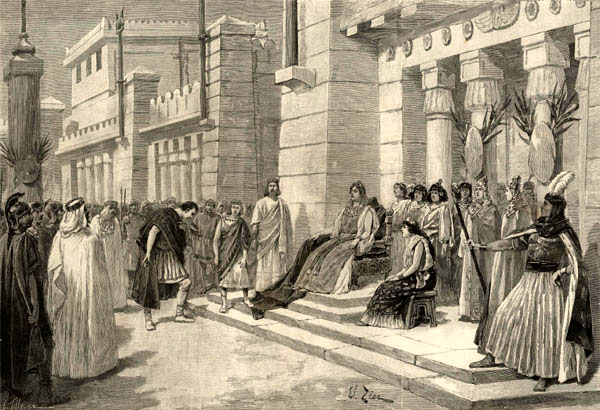
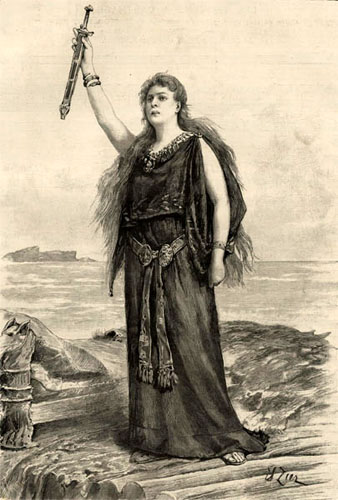

The above drawing, originally published in Le Figaro of
12 June 1910, shows the singers Renaud and Mlle Grandjean in the roles of Méphistophélès
and Marguerite respectively. The image here is reproduced courtesy of the
Bibliothèque Nationale de France, Paris.
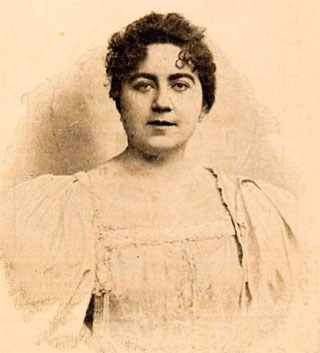
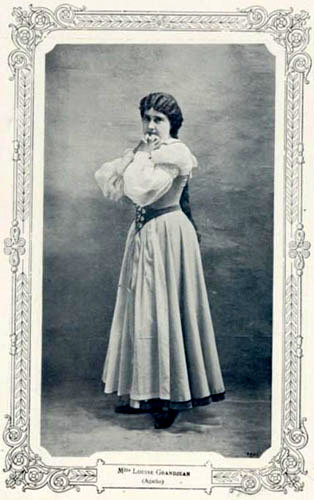
The above two pictures are courtesy of the Bibliothèque Nationale de France.
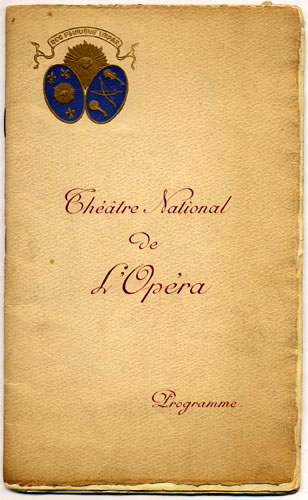
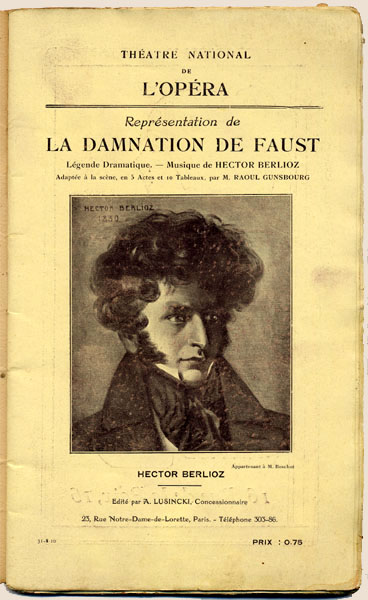
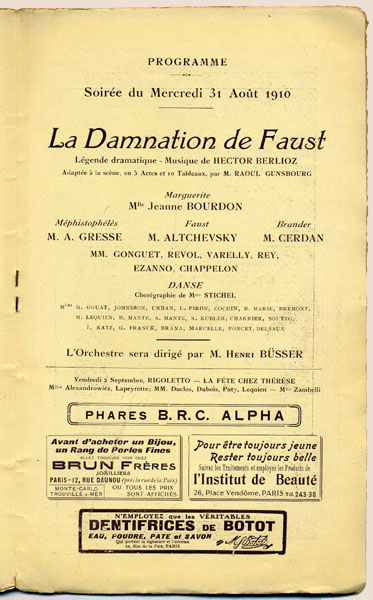

See above on Raoul Gunsbourg.
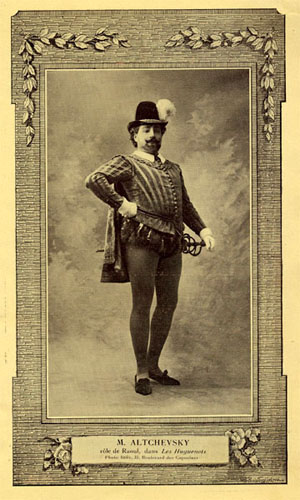
The picture shows the Russian-born tenor Altchevsky in the role of Raoul in Meyerbeer’s Les Huguenots.
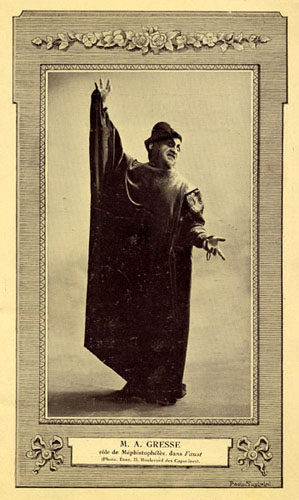
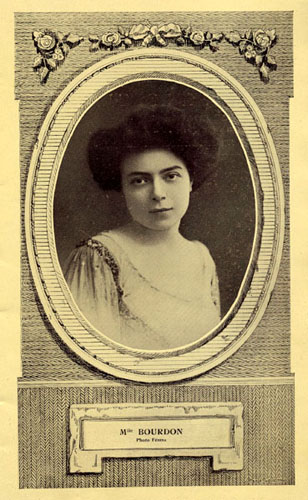
![]()
The Hector Berlioz Website was created by Monir
Tayeb and Michel Austin on 18 July 1997;
Page Berlioz: Pioneers and
Champions created on 15 March 2012; this page created on 1
July 2013, updated on 1 May 2020.
© Monir Tayeb and Michel Austin. All rights reserved.